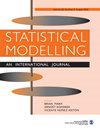非交叉分位数函数的参数估计
IF 1.2
4区 数学
Q2 STATISTICS & PROBABILITY
引用次数: 2
摘要
分位数回归(QR)在过去的几十年里得到了普及,现在被应用统计学家和各个领域的从业者认为是一种标准方法。在这项工作中,我们通过分析北极圈的历史温度,应用QR来研究气候变化。这种方法被证明是非常灵活的,可以研究分布的尾部,即与极端事件相对应的尾部。然而,分位数交叉的存在阻碍了使用拟合模型进行预测和外推。为了寻找可能的解决方案,我们首先考虑了QR的不同版本,其中QR系数由参数函数描述。这减轻了交叉问题,但并没有完全消除它。最后,我们利用强加的参数结构来制定一个强制单调性的约束优化算法。所提出的例子表明,参数分位数函数这个相对未开发的领域可以为长期存在的分位数交叉问题提供新的解决方案。我们的方法在时间序列分析等情况下特别方便,其中拟合模型可用于预测极端分位数或执行外推。所描述的估计器已经在R包qrcm中实现。本文章由计算机程序翻译,如有差异,请以英文原文为准。
Parametric estimation of non-crossing quantile functions
Quantile regression (QR) has gained popularity during the last decades, and is now considered a standard method by applied statisticians and practitioners in various fields. In this work, we applied QR to investigate climate change by analysing historical temperatures in the Arctic Circle. This approach proved very flexible and allowed to investigate the tails of the distribution, that correspond to extreme events. The presence of quantile crossing, however, prevented using the fitted model for prediction and extrapolation. In search of a possible solution, we first considered a different version of QR, in which the QR coefficients were described by parametric functions. This alleviated the crossing problem, but did not eliminate it completely. Finally, we exploited the imposed parametric structure to formulate a constrained optimization algorithm that enforced monotonicity. The proposed example showed how the relatively unexplored field of parametric quantile functions could offer new solutions to the long-standing problem of quantile crossing. Our approach is particularly convenient in situations, like the analysis of time series, in which the fitted model may be used to predict extreme quantiles or to perform extrapolation. The described estimator has been implemented in the R package qrcm.
求助全文
通过发布文献求助,成功后即可免费获取论文全文。
去求助
来源期刊

Statistical Modelling
数学-统计学与概率论
CiteScore
2.20
自引率
0.00%
发文量
16
审稿时长
>12 weeks
期刊介绍:
The primary aim of the journal is to publish original and high-quality articles that recognize statistical modelling as the general framework for the application of statistical ideas. Submissions must reflect important developments, extensions, and applications in statistical modelling. The journal also encourages submissions that describe scientifically interesting, complex or novel statistical modelling aspects from a wide diversity of disciplines, and submissions that embrace the diversity of applied statistical modelling.
 求助内容:
求助内容: 应助结果提醒方式:
应助结果提醒方式:


